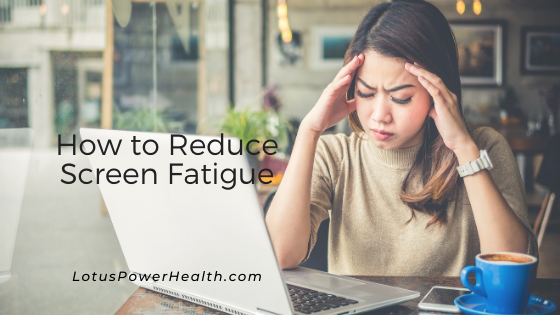What is Screen Fatigue?
Screen fatigue is a type of eye strain that comes specifically from looking at screens too often, also known as asthenopia. You might have screen fatigue if you frequently get headaches during the day if your eyes feel an ache that you can’t quite get rid of, and if the pain or tiredness of your eyes and head gets worse the later in the day, it gets. You might also find that you squint your eyes without realising it.
So, What To Do to Reduce Screen Fatigue?
There are many things you can do to reduce screen fatigue. Here are the few modifications I’d recommend you do first.
Modification #1: Take Breaks From Screens Throughout the Day
The first way to reduce screen fatigue is simply to look at screens less.
This isn’t always easy to do if you work in front of a computer, but you can find ways to take breaks.
For example: pay attention to the time. At the top of every hour, look away from your screen for a couple of minutes. You can take more breaks completely from your desk where you just walk around the office – or your home – for a few minutes. You can also set a timer to look away from the screen every 20 minutes or so for a few seconds.
Modification #2: Use Proper Lighting
Using screens in a room with harsh or harmful lighting can also bring on-screen fatigue a lot easier.
If you work in an office with bright fluorescent lighting, you need to be a little more cautious with screens. It can help to adjust those lights, if possible. If it is not possible, you should try wearing blue light blocking glasses while you are working. Otherwise, try to work in lighting that provides enough light to work, but isn’t too harsh. You also want to avoid glares on your screen from the sunlight.
Modification #3: Don’t Use Screens in Bed
I know that’s going to be a difficult one for many. Yet, if your eyes are suffering, it’s going to be a significant modification to make as well.
Try not to use screens in bed or when you don’t need them if you struggle with eye strain.
Screen fatigue is so common now that it isn’t just because of using computers during work, but using them when you aren’t working. You probably look at a screen almost all day long: your computer for work, your phone, tablet, and television. Try to at least keep them out of your bedroom.
Modification #4: Alter the Settings on Your Computer, Phone, Tablet and Other Mobile Devices
There are some settings on your computer or tablet that can reduce screen fatigue.
Adjust your monitor’s brightness so that the screen isn’t a dull grey colour (too dark) or stark white (too bright). You can adjust the text as well, either bigger or smaller than it is now.
On Your iPhone, iPad and iPod Touch
Night shift automatically adjusts your display’s colours to the warmer end of the spectrum – making the display easier on your eyes.
About Night Shift
Night Shift uses your device’s clock and geolocation to determine when it’s sunset in your location. Then it automatically shifts the colours of your display to warmer colours. In the morning, it returns the display to its regular settings.
Turn on Night Shift
There are two ways to turn Night Shift on and off:
- Open Control Center. Firmly press the Brightness control icon, then tap to turn Night Shift on or off.
- Go to Settings > Display & Brightness > Night Shift. You can schedule a time for Night Shift to turn on automatically and adjust the colour temperature on the same screen.
By default, Night Shift turns on from sunset to sunrise.
On Your Android Phone or Tablet
To activate Night Mode on your Android Phone or Tablet, follow the below steps:
- Swipe down twice at the top of your device’s screen to expand the Quick Settings menu.
- Tap Edit.
- Scroll down to the Night Modetoggle at the very bottom.
- Long-press the toggle and drag it up to the darkgrey area at the top of the menu.
On Your Computer
If you are on your laptop, I’d recommend using F.lux.
During the day, computer screens look good – they’re designed to look like the sun. But, at 9 pm, 10 pm, or 3 am, you probably shouldn’t be looking at the sun.
f.lux fixes this: it makes the colour of your computer’s display adapt to the time of day, warm at night and like sunlight during the day.
It’s even possible that you’re staying up too late because of your computer. You could use f.lux because it makes you sleep better, or you could just use it just because it makes your computer look better.
f.lux makes your computer screen look like the room you’re in, all the time. When the sun sets, it makes your computer look like your indoor lights. In the morning, it makes things look like sunlight again.

